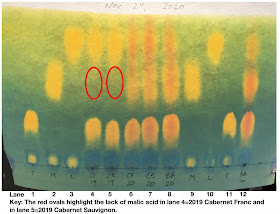Todays blog is about where our 2020 Chenin Blanc is at on it's trajectory to becoming wine. Here is a short recap. We
harvested the Chenin Blanc on Sunday, October 11, 2020 with the help of our dedicated friends. It was important that our entire harvest be brought in on Sunday because the forecast was for rain on Monday. Our friends stayed till darkness to ensure that our 12 half-ton bins were safely loaded onto the flatbed truck driven by Bill. We brought the harvest to Jonathan Edwards Winery where it went safely indoors until pressing.
The
Chenin Blanc was pressed the following day, Monday, October 12, 2020 and the weather gods were kind to us, holding off the heavy rains until later that evening. The final total weight of the harvest was 8201 pounds! The pressed juice went into two 591 gallon tanks for settling.
On October 14, the cold settled juice was racked off the gross lees and put into a holding tote while the tanks were cleaned. The juice was put back into the tanks and was warmed overnight to 62 degrees F in preparation for yeast inoculation. On October 15, the juice was
inoculated with QA23. Fermentation commenced and the finished wines were in the tanks until a few days ago.
On November 8, 2020 Jonathan Edwards took a hydrometer reading and indeed the fermentation had finished. A plan was made to move the finished wine into a holding tote and then to clean the tanks and combine the finished wines and put them into one tank.
Our plan was executed on November 10, 2020. The wines were transferred into the totes and we got down to clean the tanks. This time, there was tartrate that needed to come off of the tanks so the cleaning took a bit longer. I was able to get into the tank and see for myself what the scuz was all about.
When the tanks were cleaned, the finished wines were put back into the tank. The wine took up the entire volume of the 591 gallon which is the middle tank shown in the bottom photo. There was enough wine that the overflow went into two 15 gallon kegs and a few glass carboys.
This was an exciting day for us and we thank Jonathan Edwards for helping to shepard our Chenin Blanc grapes into wine. My husband and I reflected that the wine that was in the glass carboys was the entirety of our 2016 harvest. Things have certainly changed!




















